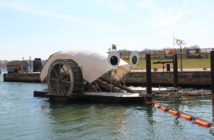Improved planning and more intelligent management of cities across the developed and developing world could play a key role in growing economies, boosting social improvements and reducing humanity’s environmental footprint.
Findings from the Green Economy report of the UN Environment Programme (UNEP) indicate that current patterns of urban development could be costing countries over three per cent of GDP as a result of congestion to welfare costs.
The cities chapter of the report, released at the Gwangju Summit of the Urban Environmental Accords in the Republic of Korea, cites Buenos Aires and Dakar as two examples where current patterns of urban development are reducing GDP by 3.4 per cent.
Current models of urban development in a city like Mexico City may be undermining the economy by over two per cent of GDP and in the European Union a lower but still significant 0.75 per cent of GDP.
Achim Steiner, UN Under Secretary General and UNEP Executive Director, said: “Without cities, a transition to a low carbon, resource efficient Green Economy as a way and as a means for implementing sustainable development, will always remain an aspiration rather than a reality—the overwhelming evidence is that the decoupling of economic growth from the consumption of natural resources will only happen if cities are committed and on board”.
“The evidence from around the globe, and the case studies from city delegates in Gwangju, is that this realization and action to re-define the urban environment as a catalyst for transformational change is understood and underway,” he said.
“Rio+20 in Brazil next June is an opportunity to scale-up and to accelerate these transformations through innovative policy switches, creative and available technologies and by capitalizing and adopting the legion of lessons and experiences that clearly illuminate a path towards a sustainable future,” he added.
According to the report, cities are facing mounting pressures to meet the demands of bourgeoning populations – from unsustainable resource use and energy consumption to insufficient infrastructure and health hazards.
While urbanization has helped to reduce absolute poverty, the number of people classified as urban poor is on the rise. Between 1993 and 2000, there was an additional 50 million poor in urban areas while the number of rural poor declined by 150 million.
The UNEP report finds that the environmental performance of cities can be enhanced through effective urban planning and sound governance.
The physical structures of cities – urban form, size, density and configuration – can be designed and managed to limit resources consumption and per capita carbon emissions.
More compact urban forms, reduced travel distances, higher density green residential and commercial buildings and investment in green public transport models lead to greater energy efficiency and reduced environmental footprints.
According to research, net residential densities of up to 3,000 persons per hectare can be reached without compromising environmental or social conditions.
Many cities around the world have recognized such structural opportunities. Compact urban development models with walkable urban neighbourhoods and green public transport have been created in cities such as Copenhagen, Oslo and Madrid in Europe and Curitiba, Vancouver and Portland in the Americas.
In high density cities such as Hong Kong and New York, housing, commercial retail and leisure facilities are in close proximity, thus limiting the lengths of everyday trips. This is supported by efficient and extensive public transport networks.
In an urban green economy, job creation can come in many forms – from urban agriculture and renewable energy to green construction and better waste management. Upgrading to greener infrastructure will also create more jobs, as will more effective recycling services. For example, in the Republic of Korea, the Ministry of Environment expects the government and private sector to spend 5.63 trillion won to expand the country’s waste to energy facilities by 2013. It has projected that this project will create 46,000 new jobs and generate savings of 1.2 trillion won from reduced waste disposal and importation of crude oil, while reducing greenhouse gas emissions.
The most significant cost savings can be derived from shifting away from infrastructure for automobiles to more efficient public transport systems, such as pedestrian and cycling paths. Studies have shown that fuel wasted in traffic jams in well-designed cities such as Curitiba, Colombia, has cost the city about US$ 930,000 compared to $13.4 million in Rio de Janeiro.
A green public transport sector also helps create jobs. In many countries, public transport jobs account for up to one and two per cent of total employment. In New York, almost 80,000 local jobs are connected to the sector and in Mumbai, there are more than 160,000 jobs involved.
Overall, greening cities reduces social inequality and improves the quality of life for its inhabitants. Research shows that creating green spaces has positive impacts on public health, as does providing access to recreational facilities, such as bicycle and walking paths.
Green cities : examples from around the word
A number of cities around the world have pioneered ambitious green policies and trajectories to improve environmental performance.
- Freiburg, a German city of 200,000 inhabitants, has reduced its Co2 emissions per capita by 12 per cent between 1992 and 2003. The city has a long tradition of constructing green buildings and recycling waste.
- The city of Curitiba, Brazil, adopts integrated land-use and sustainable transport systems. It introduced an innovative bus rapid transit system that has been in service since 1970.
- Singapore introduced the world’s first road-charging scheme in the 1980s and it is now at the forefront of sustainable policies on waste, water and the greening of the environment.
Definition reminder between cities and greencities
A city is a social, ecological and economic system within a defined geographic territory that may reflect population size, administrative or historic status.
Greening cities requires: controlling disease; reducing chemical and physical hazards; developing high-quality urban environments; minimizing the transfer of environmental costs to areas outside the city and the implementation of sustainable production and consumption patterns.
Indicators measuring the environmental performance of cities include: levels of pollution and carbon emissions, energy and water consumption, water quality, energy mix, waste volumes and recycling rates. Other indicators include: green-space ratios, primary forests and agricultural land loss, motorization rate and modal share of urban transport.
An important measure of humanity’s demand on nature is the Ecological Footprint, which measures how much biologically productive land and water area a human population or activity requires to produce the resources it consumes and to absorb its wastes.



